
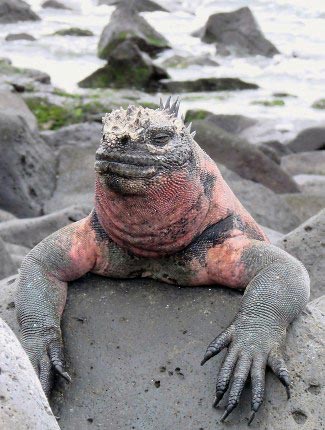
Marine Iguana by Chris Townend.
- Giant Tortoises, Marine Iguanas, American Flamingos and seabird colonies with confiding Waved Albatrosses, Red-billed Tropicbirds, Blue-footed, Red-footed and Nazca Boobies, Magnificent and Great Frigatebirds, and Swallow-tailed Gulls
- Over 30 endemic bird species including Galapagos Penguin, Flightless Cormorant, and several mockingbirds and finches
- And the chance to scuba-dive or snorkel with Whale Sharks, Manta Rays, sealions, turtles and many coral reef fish
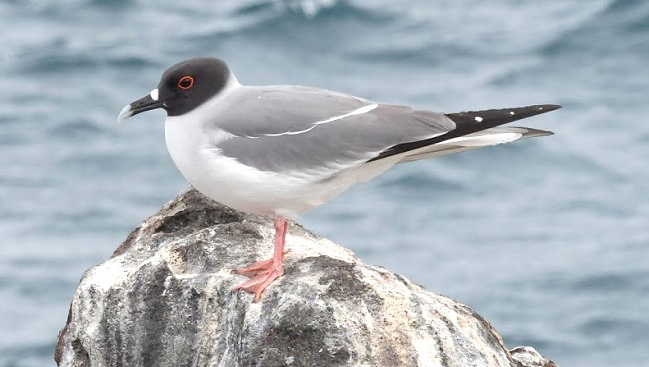
Swallow-tailed Gulls by Simon Colenutt.
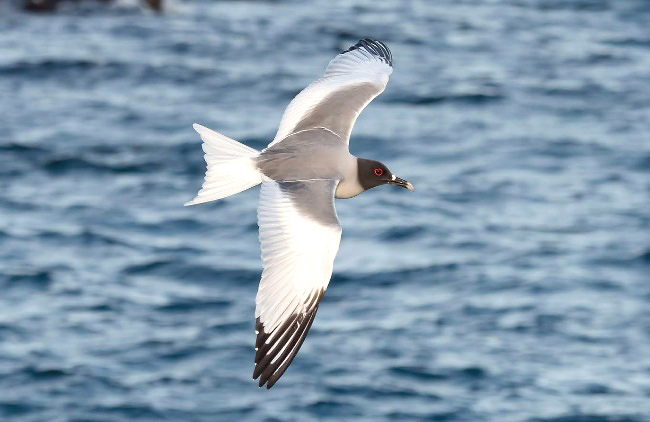
- Spanish explorers who discovered these islands in the 16th century named them Galapago, which is Spanish for tortoise. In 1784 William Dampier wrote, ‘The land-turtles [tortoises] are here so numerous, that five or six hundred men might subsist on them for several months … They are so extraordinarily large and fat, and so sweet, that no pullet eats more pleasantly.’ The next famous visitor was Charles Darwin who landed, via HMS Beagle, on Chatham (San Cristobal) on 17th September 1835. He wrote in the classic Voyage of the Beagle, ‘Nothing could be less inviting ... A broken field of black basaltic lava is every where covered by a stunted brushwood, which shows little sign of life.' Many of the Galapagos Islands are baked and bleak but he went to find plenty of life on them which, ultimately, helped him to completely change the way humans thought about life. By observing the changes which had taken place in the wildlife, notably the Giant Tortoises, during thousands of years of isolation on these new, volcanic islands, and realising that animal characters changed with time, he discovered what is now known as Evolution. Giant Tortoises can grow to a length of 1.8 metres (nearly six feet), weigh up to 400 kilograms (880 pounds) and live a very long time, over 100 years in the wild, longer than most other animals. Thanks to a reintroduction programme there are plenty left and one of the best places to see them is the humid highlands of Santa Cruz, one of the fifteen islands open to visitors in the archipelago which lies on the equator between 800 and 965 kilometres (500 and 600 miles) west of Ecuador, from which they are accessible by air via Quito. Once there, visitors are allowed to travel around by various types of boat, each with authorized itineraries to land on specific islands.
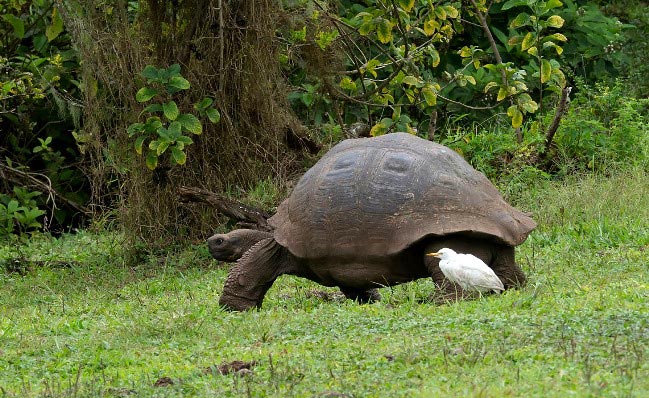
Giant Tortoise with a Cattle Egret on Santa Cruz by Simon Colenutt.
- Birders beware. To see the most endemics possible in the Galapagos it is important to choose a vessel with an authorized itinerary which includes all the key islands, especially Genovesa (Tower) which has the best seabird colony and the only accessible Red-footed Boobies and Sharp-beaked Ground-finches in Galapagos. Seeing birds such as Mangrove Finch and Vampire Ground-finch (once Sharp-beaked Ground-finch and only present on the islands of Darwin (1 sq km) and Wolf (1.3 sq km)) is especially tricky. Two of the top birds; Waved Albatross and Swallow-tailed Gull, can actually be seen with some ease away from Galapagos, at sea off Lima in Southern Peru, while small numbers of the gull also nest on the island of Malpelo off Colombia and a few Waved Albatrosses also nest on La Plata Island in Machalilla National Park on the west coast of Ecuador where it is also possible to see Red-billed Tropicbird, Magnificent Frigatebird, and Blue-footed and Nazca Boobies.
- Many tour companies include as part of their itineraries or offer as extensions at least a few days in the Andes and/or Amazonian rainforests of Northern Ecuador where it is possible to see many birds including, in the Andes, Sword-billed Hummingbird, Andean Cock-of-the-Rock, Oilbird, Toucan Barbet and numerous tanagers, and, in Amazonia, Blue-and-yellow Macaw, Hoatzin, Zigzag Heron, Wire-tailed Manakin, Black-necked Red-cotinga and Musician Wren.
Best Birds and other wildlife in the Galapagos Islands
Birds
Endemics 31 (A penguin, four mockingbirds and 17 finches) Galapagos Dove, Galapagos Rail, Galapagos Penguin, Lava (Green) Heron, Flightless Cormorant, Lava Gull, Galapagos Hawk, Galapagos Flycatcher, Darwin’s (Galapagos Vermilion) Flycatcher, Galapagos Martin, Floreana Mockingbird, Galapagos Mockingbird, Espanola Mockingbird, San Cristobal Mockingbird, Grey Warbler-finch, Green Warbler-finch, Vegetarian Finch, Sharp-beaked Ground-finch, Large Tree-finch, Medium Tree-finch (Floreana), Small Tree-finch, Mangrove Finch (Isabela), Woodpecker Finch, Vampire Ground-finch (Darwin and Wolf), Small Ground-finch, Medium Ground-finch, Genovesa Ground-finch, Large Ground-finch, Espanola Cactus-finch, Common Cactus-finch and Genovesa Cactus-finch.
(Waved Albatross nests (April to December) on Espanola Island in the Galapagos and Isla de la Plata (a few pairs only) off Ecuador, and ranges at sea to the Humboldt Current off Ecuador and Peru, sometimes Chile. Swallow-tailed Gull nests all year round on Galapagos and Mapelo Island (in small numbers) off Colombia, and ranges at sea from Colombia to Peru, rarely to central Chile)
Others
American Flamingo, Red-billed Tropicbird, Blue-footed, Red-footed and Nazca Boobies, Magnificent and Great (mostly Apr-Sep) Frigatebirds, White-cheeked
Pintail, Galapagos (Dark-rumped) Petrel, Galapagos (Audubon's) Shearwater, Elliot's, Band-rumped (Madeiran), Markham's, Wedge-rumped and White-vented
Storm-petrels, Brown Pelican, Yellow-crowned Night-heron, Purple Gallinule, Black-necked Stilt, Wandering Tattler, Brown Noddy, Smooth-billed Ani,
(Galapagos) Barn and (Galapagos) Short-eared Owls, (Galapagos) Vermilion Flycatcher and (Mangrove) Yellow Warbler. Also a chance of White-faced
Storm-petrel, Paint-billed Crake, Sooty Tern (nests only on Darwin Island, a long way north of the main archipelago, and seen infrequently elsewhere) and
Dark-billed Cuckoo.
Mammals
Bottlenose Dolphin, California Sealion (usual pupping season is Aug-Nov) and Galapagos Fur Seal. Also a chance of
Common Dolphin, and Bryde's, Killer and Sperm Whales, and an outside chance of Fraser's, Long-snouted Spinner, Pantropical Spotted, Risso's and Striped
Dolphins, and Blue, Blainville's Beaked, Cuvier's Beaked, Dwarf Sperm, Humpback (mostly June), Fin, Melon-headed, Minke, False Killer, Pygmy Killer,
Pygmy Sperm, Short-finned Pilot and Sei Whales (all whales mostly May-Nov).
Reptiles, Amphibians and Fish
Giant Tortoise, Marine and Land Iguanas,
(Pacific) Green Turtle (females come ashore to lay eggs Dec-Jun mostly Jan-Mar especially February, hatchlings mostly Apr-May), and Whale (Jun-Nov, mostly
May-Aug, when pregnant females gather around Darwin Island), (Scalloped) Hammerhead (mostly July) and White-tipped Reef Sharks. Also a chance of Manta Ray,
Golden and Spotted Eagle Rays, and Hawksbill, Leatherback and Olive Ridley Turtles.
Best Sites for Birds and other wildlife in the Galapagos Islands
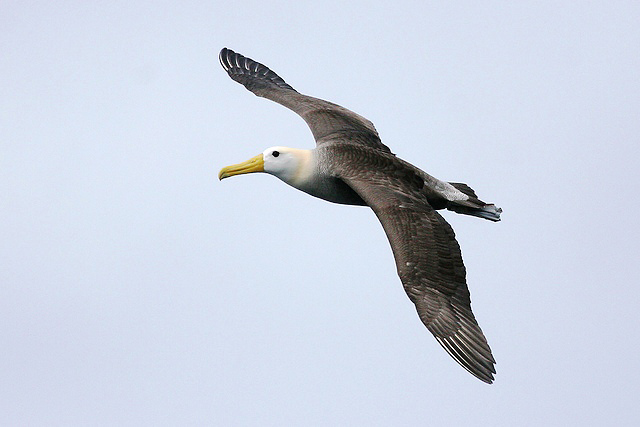
Waved Albatross by Lee Dingain.
- At sea and throughout the islands Galapagos (Dark-rumped) Petrel, Galapagos (Audubon's) Shearwater, storm-petrels, whales and dolphins.
- (North) Seymour Lava Heron, Blue-footed Booby (colony), Magnificent and mainly Great Frigatebirds (colony), Swallow-tailed and Lava Gulls, Galapagos Dove, Small Ground-finch, Land Iguana (introduced) and Galapagos Fur Seal.
- Genovesa (Tower) best seabird colony, with Red-billed Tropicbird, Blue-footed, Red-footed and Nazca Boobies, Magnificent and Great Frigatebirds, and Swallow-tailed Gull, as well as Wedge-rumped Storm-petrel (thousands flying over colony on inland lava field), Galapagos Hawk, Lava Gull, (Galapagos) Short-eared Owl, Galapagos Dove, Galapagos Mockingbird, Genovesa Cactus-finch, Genovesa and Large Ground-finches, Grey Warbler-finch, Galapagos Fur Seal, Marine Iguana, Hammerhead Shark and White-tipped Reef Shark.
- Isabela (Albemarle) Galapagos Penguin, White-cheeked Pintail, Flightless Cormorant, American Flamingo, Galapagos and Paint-billed Crakes (Volcan Sierra Negra (VSN)), Brown Noddy, Dark-billed Cuckoo, Galapagos Mockingbird, Darwin's (Vermillion) Flycatcher (VSN), Large and Small Tree-finches (VSN), Green Warbler-finch (VSN), Woodpecker Finch (VSN) and Marine Iguana. Also, the very rare Mangrove Finch occurs in the mangroves which are usually out of bounds to visitors.
- Fernandina (Narborough) the largest colony of Marine Iguanas, as well as Galapagos Penguin, Flightless Cormorant and Galapagos Mockingbird.
- Floreana (Charles) Floreana Mockingbird (on offshore islets Champion and Gardner) and Medium Tree-finch, as well as White-cheeked Pintail, American Flamingo (colony), Galapagos Flycatcher, Common Cactus-finch, Small Tree-finch and Grey Warbler-finch.
- Espanola (Hood) Waved Albatross colony, Espanola Mockingbird and Espanola Cactus-finch, as well as Lava Heron, Blue-footed (colony) and Nazca (colony) Boobies, Red-tailed Tropicbird, Galapagos Hawk, Swallow-tailed Gull, Galapagos Dove, the most colourful subspecies (venustissimus) of Marine Iguana and Galapagos Sealion.
- Santa Cruz (Indefatigable) Galapagos Crake (Ranch Media Luna on the flanks of Cerro Crocker), as well as Lava Heron, Galapagos Flycatcher, Galapagos Mockingbird, Small and Medium Ground-finches, Small Tree-finch and Vegetarian Finch. Also a chance of Paint-billed Crake and (Galapagos) Barn Owl.
- Santa Fe (Barrington) Blue-footed and Nazca Boobies, Galapagos Hawk, Galapagos Mockingbird, Galapagos Sealion and (Santa Fe) Land Iguana.
- San Cristobal (Chatham) San Cristobal Mockingbird and Vegetarian Finch, as well as Small and Medium Ground-finches, Small Tree-finch, Grey Warbler-finch and Woodpecker Finch.
- Bartolome (Bartholemew) Blue-footed Booby, Red-billed Tropicbird, Marine Iguana and a chance of swimming with Galapagos Penguins.
- Santiago (James) Galapagos Fur Seal. Also a chance of (Pacific) Green Turtle.
Best Times for Birds and other wildlife in the Galapagos Islands
Two bird species, Waved Albatross and Great Frigatebird, usually nest only from April to September, and the best time to see these, as well as Blue-footed Booby, displaying at their colonies is usually May to July, especially May-June, but the peak time for turtles laying their eggs on the beaches is January to March, especially January, with the hatchlings usually appearing in April-May. The best time for snorkelling/swimming with fish, penguins, sealions and turtles is the slightly wetter season between December and May when the waters are warmer, clearer and calmer, and the weather hotter and more humid, with the chance of showers. June to November is usually the driest, coolest and least humid time of the year but it can be misty at this time and the sea cooler, murkier and choppier.
Recommended Bird Books etc. for the Galapagos Islands
Collins Traveller's Guide: Wildlife of Galapagos by J and D Fitter. William Collins/PUP, 2016 (Revised Second Edition).
Travellers' Wildlife Guides: Ecuador and the Galapagos Islands by D Pearson and L Beletsky. Interlink Books, 2013.
Bradt Wildlife Guide: Galapagos Wildlife by D Horwell and P Oxford. Bradt, 2011 (Third Edition).
Watching Wildlife: Galapagos Islands by D Andrew. Lonely Planet, 2005.
Birds, Mammals and Reptiles of the Galapagos Islands by A Swash and R Still. Helm, 2005 (Second Edition).
Reef Fish Identification: Galapagos by P Humann and N Deloach. New World Publications, 2003 (Second Edition).
Voyage of the Beagle by Charles Darwin. Originally published in 1839 and reprinted many times since.
Where to watch birds in South America by N Wheatley. Helm, 1994.
Don’t know which country/countries to visit in South America? Then it may be worth considering taking a look at this book, written by this website’s author. It is many years old of course but it still provides a starting point, an overview and a guiding light to the best birds and the best places to look for them on the continent, and could save hours of searching for similar information on the internet. However, it is important to check more up-to-date sources for sites which have been opened up, sites and species which have been discovered, lodges that have been built etc. since the book was published.
Birding and Wildlife Trip Reports for the Galapagos Islands
Many trip reports, some for Galapagos, are posted on the websites listed here. On some of these websites some reports are independent and some are posted by tour companies who organize tours to Galapagos. These tour companies and others also post their own reports on their websites, which are listed under 'Some Organized Tours to Galapagos' below.
- The best website for trip reports is CloudBirders
- but these are also worth a look
- Birdtours
- Fatbirder
- Jon Hornbuckle
- Mammal Watching
Local bird and wildlife guides in the Galapagos Islands
The costs of organized tours partly reflect the quality of the tour leaders. Some leaders are certainly better than others and many companies claim their leaders are the best but even the best rely at least to some extent on the exceptional skills of the local guides they employ. If you are travelling independently, employing such local guides will greatly increase your chances of seeing the wildlife you wish to see.
Accommodation for birders in the Galapagos Islands
Some Organized Tours for birds and other wildlife to the Galapagos Islands
There are many tour companies who organize tours to see mammals, birds, other wildlife and other natural wonders. The cost of these tours vary considerably according to such variables as the airlines used, the number of days the tours last, the number of sites visited, the number of people in the group (an important consideration if you wish to see such wildlife as rainforest mammals and birds), the number of tour leaders, the standard of accommodation and transport, and the percentage profit the company hopes to make. Generally, where the number of days tours last and the number of sites visited are similar, the cheapest tours are those that use the cheapest airlines, accommodation and local transport, that have the largest groups with the least number of leaders, and that make the least amount of profit. The most expensive tours tend to be those which are exceptionally long, use the most expensive accommodation (ridiculously lavish in some cases, even for single nights) and which make the most profit. Some tour costs partly reflect the quality of the tour leaders. Some leaders are certainly better than others and many companies claim their leaders are the best but even the best rely at least to some extent on the exceptional skills of the local guides they employ.
While tour companies organize tours with set itineraries many also organize custom tours for individuals and private groups who instead of taking a tour with a set itinerary want to follow their own itinerary to suit their own personal tastes, whether it be mammals, birds, other wildlife, other natural wonders or even man-made attractions, or a mixture of them all. Many organized tours with set itineraries are also fast-paced and target as many species as possible, whether they are mammals, birds or other wildlife or everything, which usually leaves little time to enjoy the best sites and individual species, but on a custom tour those taking part can specify the pace and the sites and species they wish to concentrate on. Custom tours also suit people who like to travel with people they already know, rather than with a group of strangers, and people with partners with different interests. Individuals and small groups will almost certainly have to pay more than the price of an organized tour with a set itinerary but a large group of friends may be able to travel for less than the price quoted for a set tour.
Tour companies who run organized tours or can arrange custom tours to Galapagos include the following.
